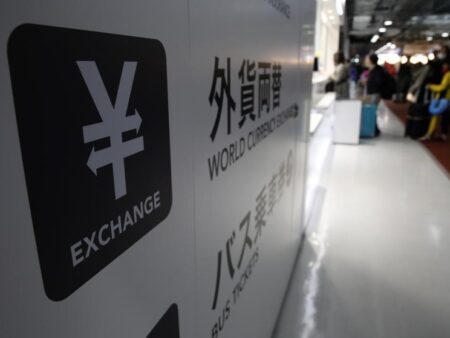Investing.com– Most Asian currencies were largely unchanged on Wednesday, while the Japanese yen firmed against the dollar as markets were worried about the implications of new tariffs under incoming U.S. President Donald Trump.
The dollar retreated slightly as focus turned to crucial economic data from the world’s largest economy for more cues on interest rates.
On Tuesday, Trump renewed his vow to impose sweeping tariffs on Chinese imports, promising a 10% additional tariff on all goods from China and 25% tariffs on products from Mexico and Canada. This vow has reignited fears of a global trade war, with dire implications for Asian economies that are heavily reliant on trade.
The edged lower in Asian trade, after gaining in the previous session. also ticked down.
The Chinese yuan continued to remain under pressure on Wednesday, with the onshore yuan’s pair rising 0.1% and hovering near a four-month high. The pair had risen 0.2% in the previous session.
Other regional currencies were also under pressure as concerns over global economic growth and trade friction weighed on sentiment.
The Singapore dollar’s pair rose marginally, and the Thai baht’s pair fell 0.1%.
The Australian dollar’s pair was flat following mixed , which showed headline inflation remained steady while underlying inflation rose in October.
The Japanese yen’s pair fell 0.5% as traders sought safe-haven assets amid renewed trade tensions, while the Indian rupee’s pair edged up 0.1%, remaining close to recent record highs.
Meanwhile, the New Zealand dollar’s pair rebounded from multi-month lows with a 0.5% rise, after the country’s central bank cut by 50 basis points and signaled further easing early next year, citing subdued domestic economic activity and waning inflationary pressures.
Markets await U.S. data for cues on Fed’s rate outlook
Market focus was now on data, due later on Wednesday. The reading is the Federal Reserve’s preferred inflation gauge, and comes after the of the central bank’s November meeting showed policymakers split over plans for future rate cuts.
A revised reading on third-quarter U.S. data is also due later in the day.
Recent signs of resilience in the U.S. economy spurred some doubts over just how much impetus the Fed has to keep cutting interest rates rapidly. Traders were seen paring some bets that the Fed will cut rates in December, especially after strong inflation readings for October.
While a potential rate cut by the Fed could offer some relief to emerging markets, any signs of persistent inflation or slower rate easing are likely to pressure Asian currencies.
Trump’s tariff vow rattles trade-driven currencies
The Malaysian ringgit’s pair fell 0.2%, while the South Korean won’s , and the Philippine peso’s pairs were largely unchanged.
Emerging market currencies, particularly those with high trade exposure to China, are feeling the strain. The Malaysian ringgit, Thai baht, and South Korean won have all weakened, with the ringgit and baht falling by around 2% since Trump’s electoral victory on November 5. These currencies, along with others like the Indian rupee and the Philippine peso, are vulnerable to the ripple effects of higher tariffs, as trade-reliant economies are likely to bear the brunt of any U.S. actions.
Countries like South Korea and Singapore, which have strong trade ties to the U.S. and China, could see their currencies continue to weaken if the tariffs are imposed. Analysts expect these developments to challenge the stability of Asian currencies in the coming months, as investors hedge against the potential fallout from a revived U.S.-China trade war.

















